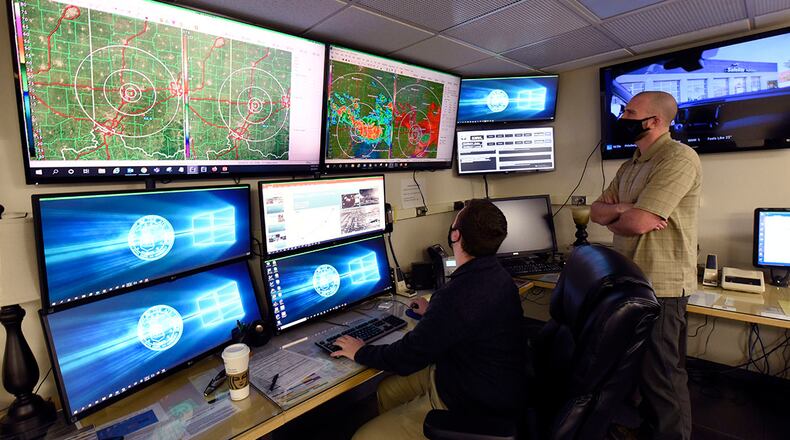“It changes every day, especially here in the Miami Valley,” he said. “Our area is unique because of the fact that it’s where the cold meets the warm. So, we get sometimes four seasons in one day, many times.”
Lane leads a team of 10 contract forecasters in the Base Operations Building to support the aviation mission through briefings, observations and forecasting.
“Not only do they provide weather watches and warnings for the whole base, specifically, they’re also monitoring the winds to determine the active runway or calling lightning within 5-10 miles from the airfield to keep people safe on the flightline,” said John Vance, the 88 OSS special operations director. “Weather and aviation go hand in hand; it affects everything. It’s routine, but it’s routinely critical. Nobody flies without checking the weather.”
The balance of the mission is resource protection for all of Wright-Patterson AFB in the form of severe weather watches, warnings and advisories, Lane said.
The station’s weather technicians make hourly observations from the flightline side of Bldg. 206 and add the data into forecasts that are released three times a day: 6 a.m., 2 p.m. and 10 p.m.
“We’re also a part of the snow team and we work with snow control, delay, early release or closure,” Lane added. “We’ve been instrumental in making those calls. And that happens at 4:30 in the morning. We have forecasters on shift around the clock.”
Credit: Air Force Materiel Command
Credit: Air Force Materiel Command
Technology a big factor in forecast accuracy
New technology and data-gathering are driving better forecasting. Most airliners crisscrossing the U.S. send weather data such as temperature, wind and humidity to the National Oceanic and Atmospheric Administration’s Forecast Systems Laboratory, which is used to build forecast models.
“We are almost saturated with data,” Lane said. “If you put all 10 of our weather forecasters in a room together with all the data, you’ll get 10 different solutions from the data. But then, we’ll discuss that amongst each other and come to some type of agreement.
“Ultimately, the forecaster at the desk gets the final word on the forecast. And if he’s right, we’ll pass the bowling pin trophy to him.”
Several consistent days of accurate forecasts in February and March had weather technician Zach Grandin in possession of the trophy for nearly a month.
“With severe-storm sensing, if you get a watch or warning advisory from any official source, and you ignore it, that’s on you.” Lane said. “Because radar technology has come that far. Now, it’s really pinpointing. And snow forecasting is becoming a lot better because of the data gathering.
“It’s challenging to forecast here at Wright-Patt, but it’s fun and ever-changing. Some weeks, it’s easy money, but other weeks it’s as challenging as it can be.”
That may explain a placard sign in the weather station, which reads: “A NON PROPHET ORGANIZATION.”
Credit: Air Force Materiel Command
Credit: Air Force Materiel Command
About the Author


